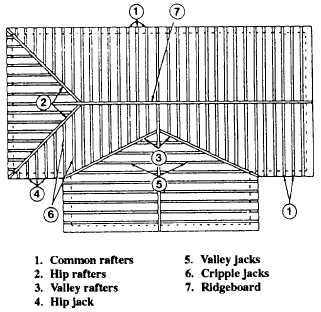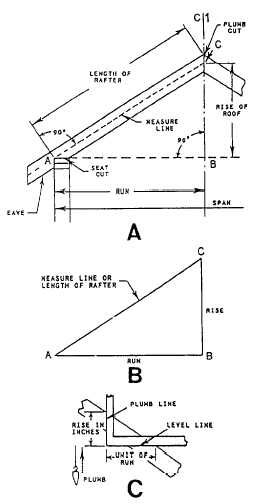Figure 2-3.-Rafter terms.
Rafter
The members making up the main body of the
framework of all roofs are called rafters. They do for the
roof what the joists do for the floor and what the studs
do for the wall. Rafters are inclined members spaced
from 16 to 48 inches apart. They vary in size, depending
on their length and spacing. The tops of the inclined
rafters are fastened in one of several ways determined
by the type of roof. The bottoms of the rafters rest on
the plate member, providing a connecting link between
the wall and the roof. The rafters are really functional
parts of both the walls and the roof.
The structural relationship between the rafters and
the wall is the same in all types of roofs. The rafters are
not framed into the plate, but are simply nailed to it.
Some are cut to fit the plate, whereas others, in hasty
construction, are merely laid on top of the plate and
nailed in place. Rafters usually extend a short distance
beyond the wall to form the eaves (overhang) and
protect the sides of the building. Features associated
with various rafter types and terminology are shown in
figure 2-3.
Common rafters extend from the plate to the
ridgeboard at right angles to both. Hip rafters extend
diagonally from the outside corner formed by
perpendicular plates to the ridgeboard. Valley rafters
extend from the plates to the ridgeboard along the lines
where two roofs intersect. Jack rafters never extend the
Figure 2-4.—Rafter layout.
full distance from plate to ridgeboard. Jack rafters are
subdivided into the hip, valley, and cripple jacks.
In a hip jack, the lower ends rest on the plate and the
upper ends against the hip rafter. In a valley jack the
lower ends rest against the valley rafters and the upper
ends against the ridgeboard. A cripple jack is nailed
between hip and valley rafters.
Rafters are cut in three basic ways (shown in
fig. 2-4, view A). The top cut, also called the plumb cut,
is made at the end of the rafter to be placed against the
ridgeboard or, if the ridgeboard is omitted, against the
opposite rafters. A seat, bottom, or heel cut is made at
the end of the rafter that is to rest on the plate. A side cut
(not shown in fig. 2-4), also called a cheek cut, is a bevel
cut on the side of a rafter to make it fit against another
frame member.
Rafter length is the shortest distance between the
outer edge of the top plate and the center of the ridge
line. The cave, tail, or overhang is the portion of the
2-3




